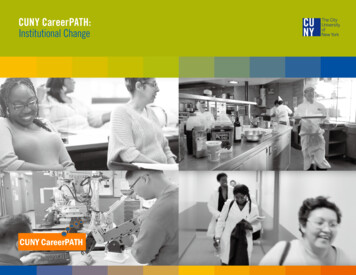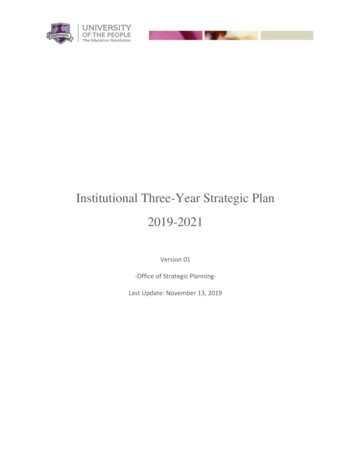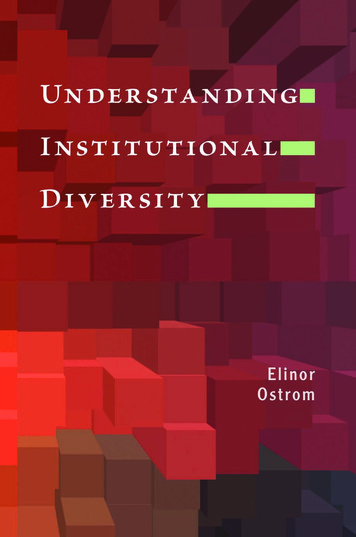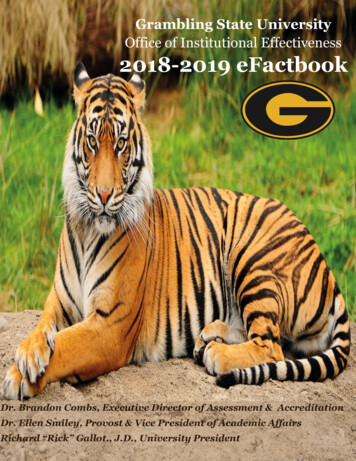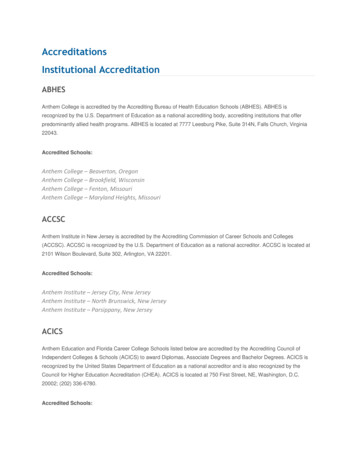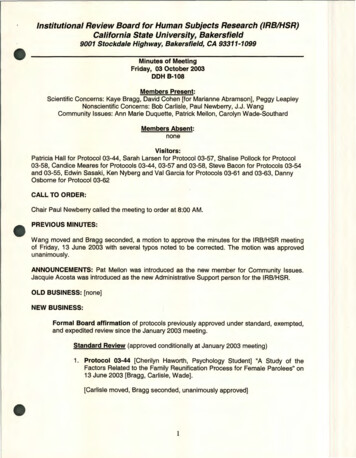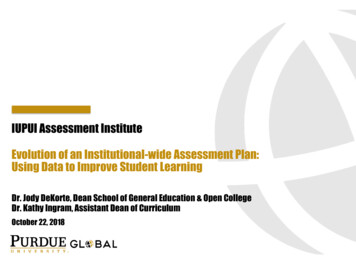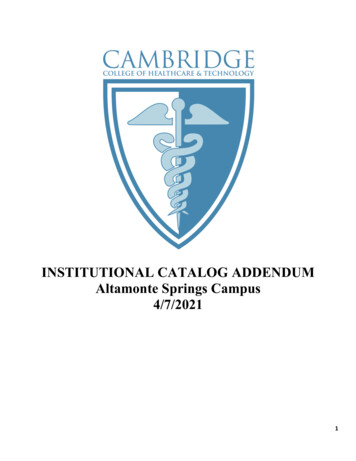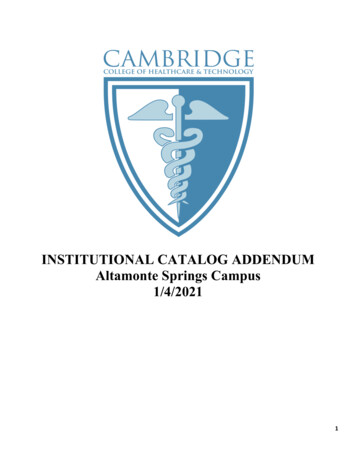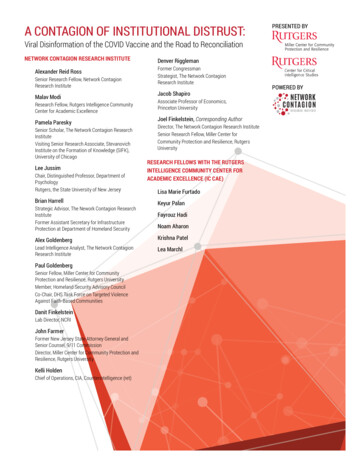
Transcription
A CONTAGION OF INSTITUTIONAL DISTRUST:PRESENTED BYViral Disinformation of the COVID Vaccine and the Road to ReconciliationNETWORK CONTAGION RESEARCH INSTITUTEAlexander Reid RossSenior Research Fellow, Network ContagionResearch InstituteMalav ModiResearch Fellow, Rutgers Intelligence CommunityCenter for Academic ExcellencePamela PareskySenior Scholar, The Network Contagion ResearchInstituteVisiting Senior Research Associate, StevanovichInstitute on the Formation of Knowledge (SIFK),University of ChicagoLee JussimChair, Distinguished Professor, Department ofPsychologyRutgers, the State University of New JerseyBrian HarrellStrategic Advisor, The Nework Contagion ResearchInstituteFormer Assistant Secretary for InfrastructureProtection at Department of Homeland SecurityDenver RigglemanFormer CongressmanStrategist, The Network ContagionResearch InstituteJacob ShapiroAssociate Professor of Economics,Princeton UniversityJoel Finkelstein, Corresponding AuthorDirector, The Network Contagion Research InstituteSenior Research Fellow, Miller Center forCommunity Protection and Resilience, RutgersUniversityRESEARCH FELLOWS WITH THE RUTGERSINTELLIGENCE COMMUNITY CENTER FORACADEMIC EXCELLENCE (IC CAE)Lisa Marie FurtadoKeyur PalanFayrouz HadiNoam AharonAlex GoldenbergKrishna PatelLead Intelligence Analyst, The Network ContagionResearch InstituteLea MarchlPaul GoldenbergSenior Fellow, Miller Center for CommunityProtection and Resilience, Rutgers UniversityMember, Homeland Security Advisory CouncilCo-Chair, DHS Task Force on Targeted ViolenceAgainst Faith-Based CommunitiesDanit FinkelsteinLab Director, NCRIJohn FarmerFormer New Jersey State Attorney General andSenior Counsel, 9/11 CommissionDirector, Miller Center for Community Protection andResilience, Rutgers UniversityKelli HoldenChief of Operations, CIA, Counterintelligence (ret)POWERED BY
A CONTAGION OF INSTITUTIONAL DISTRUST:FOREWORDMany thought it was the Russians; others felt it was Trump. Some thought itwas pedophiles needing to be locked up in Guantanamo Bay. Others thoughtit was QAnon or the proud boys, perhaps Antifa or Soros. History being whatit is, as the list gets thinner, the antisemites always suspect the Jews. Theyare all, of course, wrong.With these maps in hand, we must now come together as Americans to lookpast the caricatures, blame, and the lies because the path to public health,the path to healing, is now sewn directly to our commitments to one anotherand to renewing our democracy. Our fight against tyranny, conspiracy, andcorrosive mutual distrust now stands on our ability as Americans to rejectthe disgust of blame. We must appeal, through coherent reason, toward asober consensus of unlikely collaborators. This effort will require courageand character and test our patriotic commitments to one another and ourconstitution. If that sounds idealistic and all-too-earnest, take heart, itmerely renews an old story passed down to us from our founding fathers —astory about how our country was founded.It would appear we, the American people—the structure of our discourse anddivision, our endorsement of disinformation and distrust—are the enemy ofdemocracy we have been waiting for.Denver RigglemanThis is a moment of truth for our democracy.As unprecedented political violence from the right invades our capitol, asmass rioting from the left scars downtown areas in major U.S. cities, andas conspiracies spread like wildfire, the true enemy of our democracy hasfinally made its identity clear.As a virus that knows no race, that consumes the poor and rich, that infectsand kills people of any political persuasion grows in our democracy, acontagion of distrust appears in its wake. Conspiracy eats at the trust wehave for one another as fellow Americans by casting doubt on the Americanproject itself.This is true not merely for the “conspiracy groups” who many deride asmerely mentally ill, but also for the unreasoned witch hunts which seek tocensor them out of existence. While we must not withhold truth where itis merited, these crimes and conspiracy cults are of sobering concern—wemust also avoid dehumanizing the culprits. Like a pinata, the conspiraciesare falling out like candy when we beat them too aggressively. The distrusttakes on new forms—always enterprising, conspiracy now takes aim at thevery oxygen we would need to defeat it—our public health.Former Congressman, Virginia’s 5th District; Chief Strategist, The Center forDisinformation Defense, The Network Contagion Research InstituteJoel FinkelsteinDirector, The Network Contagion Research Institute, Ph.D. in Psychology fromPrinceton; Senior Research Fellow, Miller Center for Community Protection andResilience, Rutgers University“A Contagion of Institutional Distrust,” the latest research from the NetworkContagion Research Institute, maps how a broad swath of Americans aremobilizing against vaccines and public health restrictions and seeks to mapthat mistrust in the same way we are mapping the virus itself. The reportoffers us incredibly important new tools, such as methods to detect andforecast emerging threats to our democracy and public health at the countylevel, from social media platforms that are becoming increasingly sovereignfrom democratic control. More importantly, it maps the underlying concernsof our fellow Americans, who, as it turns out, are mothers who want theirchildren to return to school or people understandably concerned aboutgovernment excess, more often than they are people who believe Aliens arestealing our election.2
A CONTAGION OF INSTITUTIONAL DISTRUST:INTRODUCTIONIn the wake of the January 6th attack on the Capitol and the mass online deplatforming thatfollowed, researchers at the Network Contagion Research Institute (NCRI) report three troublingtrends: Mass online deplatforming and other efforts to censor conspiracy theories seem to beinterpreted by conspiracy theorists as evidence of a conspiracy. Mass deplatforming may have made conspiracy theories more difficult to detect for tworeasons: First, some conspiracy theories and their adherents, including QAnon, have movedto private channels and platforms, or to the dark web. Second, conspiracy theorists arecreating and disseminating memes on mainstream social media platforms that are difficultfor tech companies to censor because they are more generic and less likely to arousesuspicion. These memes revive “New World Order” (“NWO”) kinds of conspiracy theories,which revolves around distrust in institutions and leaders and allegations of a “one worldgovernment.” Included in the overarching anti-government, anti-institution conspiracy theory are theoriesthat create resistance to both the Covid vaccine and various public health measures intendedto combat the spread of Covid.This report chronicles the emergence of a broad, anti-government conspiracy theory that has“Big Brother” elements. It highlights the themes that this overarching conspiracy theory shareswith deplatformed conspiracy theories, illustrates the unintended consequences of social mediadeplatforming, maps the adoption of anti-vaccination and anti-public health restrictions aselements of the broader conspiracy theory, and indicates that the New World Order conspiracytheory is a statistical indicator of real-world anti-vaccine and anti-restriction protests. Thisunderscores the complexities inherent in using social media censorship as a tactic to defeatdisinformation and points to the need for continued vigilance in monitoring online extremism inorder to detect potential threats, understand public concerns, and find ways for institutions toregain public trust.KEY FINDINGS1.In the wake of the election and events of January 6th, articles and memes containingthe term “New World Order” and other anti-government and anti-“globalist” symbols notonly exploded on fringe Web communities and fake news platforms but surged acrossmainstream platforms, making them available to those not already immersed in the worldof conspiracy theories.2.“New World Order” and other anti-government and anti-”globalist” online content spikedin tandem with vaccine distribution disruption during an anti-vaccine protest at DodgerStadium.3.Anti-government and anti-“globalist” content on social media increasingly includes antirestriction and anti-vaccine content.4.NCRI analysis indicates three key statistical indicators of anti-restriction and anti-vaccineprotests at the county level: A county’s history of intimidating counterprotest activity running concurrent with BlackLives Matter protests. The severity of covid restrictions (such as enforced lockdowns). Searches for “New World Order” on Google3
A CONTAGION OF INSTITUTIONAL DISTRUST:5.NCRI aggregates data sets both in the real world and online to perform a geographicallyweighted regression which provides a spatial model for anti-restriction and anti-vaccineprotests for counties across the U.S.UNCERTAINTY, TRANSPARENCY, AND TRUSTOn January 30, protesters in Los Angeles disrupted one of the largest vaccine distribution sitesin the US, interrupting vaccinations for nearly an hour. Roughly fifty people gathered at theentrance of Dodger Stadium, forcing the fire department to close the gates. Brought togetherfor a “Scamdemic Protest/March” organized on Facebook, the LA incident is an example of theanti-restriction and anti-vaccine protests that have emerged regularly and nationwide since theearly lockdowns.A January 23rd protest at Dodger Stadium—one of the largestvaccination sites in the country—resulted in a temporary closingof the entrance to the stadium.Conspiracy theories are a method of grappling with uncertainty. They represent an explanatoryframework that works to make sense of a world that, to the conspiracy theorist, is chaotic andthreatening. Especially when things seem out of control, it is easier to accuse evildoers of secretlycontrolling the world than it is to accept that bad things happen for complex and sometimesunknown reasons. Given that pandemic represents a threat to life and well-being, and thegovernment’s responses to it can be experienced as both chaotic and a threat to liberty, it isunsurprising that conspiracy theories about the pandemic and responses to it have proliferated.One way to corrode liberal democracy is to undermine support for its institutions. Mixedmessages and double standards in both censorship and public health restrictions appearto validate conspiracy theorists’ claims. Qanon and Trump were banned from several onlineplatforms while simultaneously, the social media app, Parler, was cut off by Amazon, Google,and Apple. Meanwhile, restrictions (e.g. prohibitions on indoor dining and restaurant and otherbuilding closures), and safety measures (e.g. social isolation, masks, and distancing) have beenin place far longer than initially communicated. Vaccines, created at an unprecedented pace,were followed by a chaotic roll-out that included confusion about qualifications for vaccination(e.g. the elderly versus people of color). Contradictory government information about masks andherd immunity were issued at the highest levels, and during the height of the “lockdowns,” publichealth officials gave Black Lives Matter protests their stamp of approval while insisting that othermass gatherings were unsafe. These all provide fodder for such conspiracy theories.Facebook meme illustrating concerns embedded in Covid-relatedconspiracy theories.While exaggerated, conspiracy theories often contain a grain of truth. In this case, swift changesin election law, which allowed an unprecedented number of mail-in ballots, also created legitimateconcerns about whether procedures could be implemented quickly enough to prevent fraud.The hurried response to Covid combined with the media’s anti-Trump stance and the summer’spolitical unrest created legitimate concerns about ideology taking precedence over “science.”Tech platforms and public health officials have not always been correct in their assessmentsor honest in their public statements, and have not always lived up to democratic norms oftransparency and protection of individual rights. These failures feed conspiracy theories thatcast such failings not as inevitable failures of fallible humans coping with a crisis unprecedentedin our lifetimes, but as the sinister workings of powerful cabals of bad actors seeking power anddomination.4
A CONTAGION OF INSTITUTIONAL DISTRUST:After conspiracy groups such as QAnon were banned from mainstream social media platforms,new memes began to appear that incorporate many of their themes but seem designed tohave wider popular appeal and escape censorship on mainstream platforms. Memes such as“COVID1984,” for example, steer legitimate concerns about contradictory information, publichealth restrictions, vaccine efficacy, and censorship of unpopular ideas toward a belief in anominous totalitarian enemy with tentacles in “big tech,” media, and government.As the historical vaccine roll-out is underway, largely peaceful protests about restrictions haveemerged nationwide. However, a rash of non-compliance and potential disruption based onconspiracy theories is beginning to emerge with this movement in the form of maskless shoppersstorming shopping centers, vaccine supplies being deliberately sabotaged and protestersactively disrupting distribution. While most protesters are simply parents who want their childrento return to school or play sports again, a set of malignant actors appear to be along for the ride.Disinformation and conspiracy theories about other vaccines have been around for decades, butduring a pandemic of this magnitude, disinformation about safety measures and Covid vaccinespose a substantial risk to public health.The unwillingness to take the vaccine is grounded in the same distrust in leaders and institutionsthat led to the attack on the Capitol. For anti-democratic actors, this offers the opportunity tocreate a spiral of distrust: The more distrust in leaders and institutions they sow, the longer it willtake to vaccinate enough of the population to achieve herd immunity; the longer it takes to achieveherd immunity, the longer it will take for life to get back to normal; the longer it takes for life to getback to normal, the less credible leaders appear and the lower the public’s trust in institutions.Conspiracy theorists increasing focus on the vaccine and public health restrictions (masks, socialdistancing, quarantines/lockdowns etc.), paired with increasing distrust in institutions, not onlycreates the risk of spreading Covid, but also risks spreading extremist disinformation, institutionaldistrust, and the corrosion of liberal democratic norms.New World Order (NWO) conspiracy theories appear to be expanding as a popular meme onfringe communities, and articles on the subject have surged across the Web, also appearingon mainstream platforms such as Twitter.FREQUENCY OF “NWO”We examined the frequency of the term “NWO” (code for New World Order) on several fringecommunities, including Parler, Thedonald.win and 8Kun. The term has roots in the 1960s andwas popularized by anti-government extremists in the 1990s. The “New World Order” refers to atyrannical “one-world” government facilitated by a cabal of elites via “false-flag” events to enactrepressive measures against citizens. Our analysis suggests that days after the election, NWOconspiracy theory activity began spiking on fringe online communities. It spiked again in the daysafter the events of January 6th including on January 8th, when President Trump lost access tohis Twitter account.5
A CONTAGION OF INSTITUTIONAL DISTRUST:Fig 1. On fringe communities, thedonald.win, 8kun, and Parler mentions of NWO (new world order conspiracy theory)exploded days after the election (1st black line indicates the day after the election), and then again in the days followingthe events of Jan 6th (2nd black line) and after the deplatforming of President Trump which occurred on January 8th.6
A CONTAGION OF INSTITUTIONAL DISTRUST:“NWO” TOPIC NETWORKSA topic network generated from over 1.5 million original tweets using the term “new world order”illustrates that the term attracts themes of global takeover, with elements of QAnon mythologyand concerns that the virus is either a scam or being used to initiate global control.Fig 2. A topic network, generated from over 1.5 million original tweets using the term “newworldorder” on Twitter fromJanuary 1st, 2016 - February 17th, 2021.7
A CONTAGION OF INSTITUTIONAL DISTRUST:From comments on several fringe communities1, we mapped the “NWO” topic network2. Ouranalysis of NWO before and after the election indicates thematic changes in the NWO conspiracytheory. It appears that before the election (See figure 3, left of the red line) the term worked as acatch-all for nefarious attempts at global control including “globalists,” “communists,” criminals,foreign entities and supernatural forces of evil. After the election (See figure 3, right of the redline), a number of notable changes became evident: The term closest to NWO in the topic network is “takeover” A “Coup” cluster has emerged The term “censorship” appears adjacent to both the “coup” and “takeover” nodes The term “pharma” has entered the topic network adjacent to “globalism” and “deception” The presence of a “pedophile” cluster (adjacent to “coup” and proximate to “DNC”) increases.This suggests the absorption of QAnon conspiracy into the topic network.Fig 3. A topic network for the term “NWO” sampled from over 30,000 comments over six month across several fringeWeb communities from the three months before the 2020 election (left of the red line) and the three months after (right).1 30k comments from 4chan, 8kun, parler, thedonald with the term “nwo” from November 1st, 2019 - November 3rd2020 (Graph I) and November 4th, 2020 - February 12th, 2021 (Graph II)2 For methods see https://arxiv.org/abs/1809.016448
A CONTAGION OF INSTITUTIONAL DISTRUST:“NWO” ARTICLESUsing Storyzy, a technology that categorizes disinformation sites and video channels as either“trusted” sources, sources of disinformation, or “uncategorized” (legitimacy is undetermined),we ran a search on the volume of original articles containing the term “new world order.” Ouranalysis indicates that a surge in articles with “new world order” in the title or the body of the textemerged shortly after the events of January 6th, largely from Web domains that Storyzy couldnot characterize.Fig 4 Analysis on volume of original articles containing the terms “new world order” from August 2020 to January 2021.Uncategorized sources are usually new disinformation sources. Articles containing the term spiked after Jan 6.MAINSTREAMING “NWO”The trends we discovered on Twitter reflect the same changes we observed in our analysis offringe platforms, with “new world order” spiking around the election and following January 6th(figure 5).Taken together, these findings tend to indicate that conspiracy theories about the election, QAnonconspiracy theories about pedophiles, and traditional apocalyptic, militia conspiracy theories areall blending into an overarching “New World Order” conspiracy theories.Fig 5 Number of comments per day using the terms “nwo” or “new world order” on Twitter shows spiking in the daysfollowing the 2020 election (1st black line) and in the days following January 6th (2nd black line).9
A CONTAGION OF INSTITUTIONAL DISTRUST:NWO-related conspiracy memes and codewords spiked during the Dodger Stadium antivaccine protest.The event in Dodger Stadium was organized on Facebook using the “scamdemic” meme. Asexpected, a frequency analysis3 during the mobilization event on Twitter shows the word“scamdemic” spiking. To contextualize this signal, we ran a hashtag analysis over commentsthat contained the term“scamdemic” found that concerns of dystopian government overreachrepresented as the #greatreset (a world economic forum plans to restructure the
Director, The Network Contagion Research Institute, Ph.D. in Psychology from . “Big Brother” elements. It highlights the themes that this overarching conspiracy theory shares . disinformation and points to the need for continued vigilance in monitoring online extremism in order to detect potential threats, understand public concerns .
